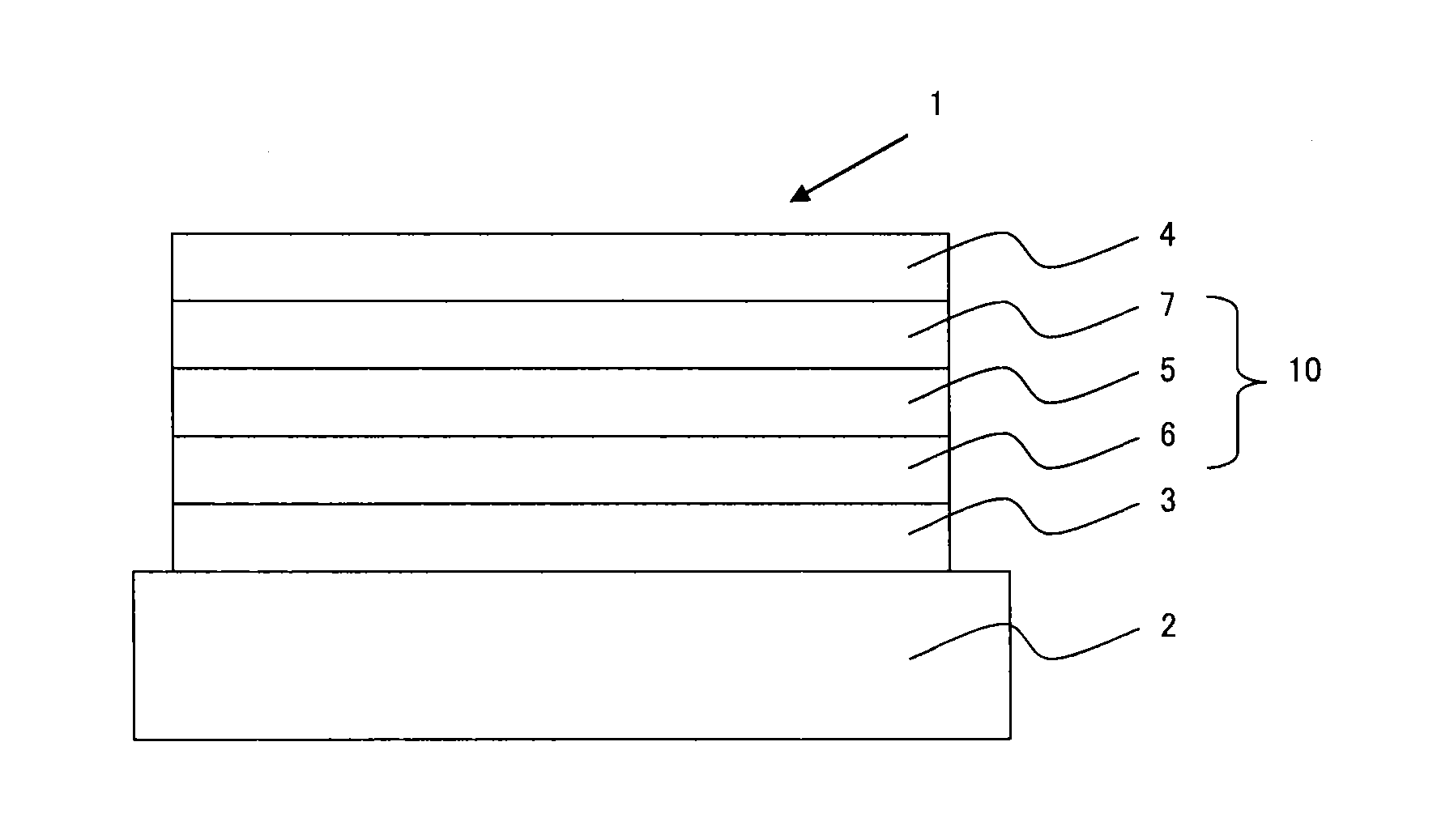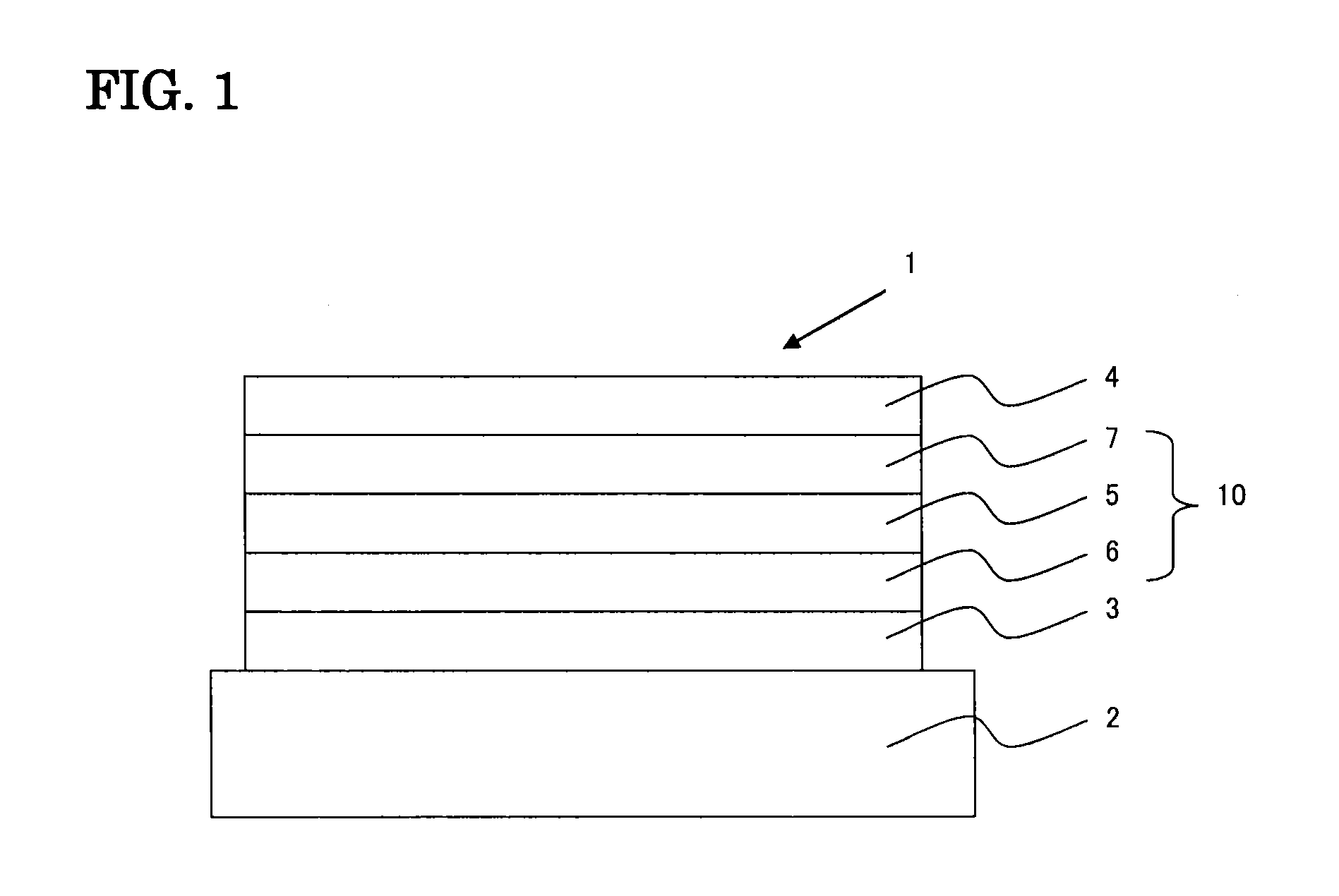Organic electroluminescence
a technology of fused ring amine and organic electroluminescence, which is applied in the field of organic electroluminescence, can solve the problems of insufficient lifetime and emission efficiency
- Summary
- Abstract
- Description
- Claims
- Application Information
AI Technical Summary
Benefits of technology
Problems solved by technology
Method used
Image
Examples
synthesis example 1
Synthesis of Compound 1
[0178]
[0179]In a 500-mL four-necked flask, 9-bromonaphtho[2,1-b]benzofuran (2.0 g, 6.7 mmol) was dissolved in chloroform (140 mL). After gradually adding a solution of bromine (0.4 mL, 7.8 mmol, 1.2 eq.) in chloroform (5.0 mL), the resultant mixture was stirred at room temperature for 5 h and at 50° C. for 2.5 h. The reaction solution was added with methanol, and the precipitated solid was collected by filtration to obtain the intermediate 1 (1.8 g, yield: 72%). The identification of the intermediate 1 was made by FDMS (field desorption mass spectrometry) analysis.
[0180]In a 500-mL four-necked flask, the intermediate 1 (1.8 g, 4.8 mmol), diphenylamine (2.0 g, 12 mmol, 2.5 eq.), tris(dibenzylideneacetone)palladium (0.26 g, 0.28 mmol, 6.0 mol %), and sodium t-butoxide (1.4 g, 15 mmol, 3.0 eq.) were charged. After replacing the inner atmosphere with nitrogen, dry toluene (50 mL) and a 3 M toluene solution of tri-t-butylphosphine (78 μL, 0.23 mmol, 4.8 mol %) were...
synthesis example 2
Synthesis of Compound 2
[0182]
[0183]In a 500-mL four-necked flask, the intermediate 1 (2.4 g, 6.4 mmol), ditolylamine (2.5 g, 13 mmol, 2.0 eq.), tris(dibenzylideneacetone)palladium (0.35 g, 0.38 mmol, 6.0 mol %), and sodium t-butoxide (1.4 g, 15 mmol, 2.3 eq.) were charged. After replacing the inner atmosphere with nitrogen, dry toluene (60 mL) and a 3 M toluene solution of tri-t-butylphosphine (100 μL, 0.30 mmol, 4.7 mol %) were added, and the resultant mixture was refluxed for 16 h under heating.
[0184]After cooling to room temperature, the reaction solution was added with water and extracted with toluene. The extract was dried over sodium sulfate and concentrated under reduced pressure. The obtained crude product was purified by column chromatography to obtain the target compound 2 (1.6 g, 2.6 mmol, yield: 41%). The identification of the compound 2 was made by FDMS (field desorption mass spectrometry) analysis.
synthesis example 3
Synthesis of Compound 3
[0185]
[0186]In a 300-mL three-necked flask, the intermediate 1 (3.0 g, 8.0 mmol), N-phenyl-2-dibenzofuranamine (4.2 g, 16 mmol, 2.0 eq.), tris(dibenzylideneacetone)palladium (0.44 g, 0.48 mmol, 6 mol %), a 8.23 M toluene solution of tri-t-butylphosphine (47 μL, 0.39 mmol, 4.8 mol %), and sodium t-butoxide (1.7 g, 18 mmol, 2.2 eq.) were charged. After adding dry toluene (32 mL), the resultant mixture was refluxed for 5 h under heating. The reaction solution was washed with a saturated saline solution and extracted with toluene. The organic layer was dried over sodium sulfate and then concentrated. The obtained crude product was purified by column chromatography to obtain the target compound 3 (4.4 g, 5.9 mmol, yield: 74%). The identification of the compound 3 was made by FDMS (field desorption mass spectrometry) analysis.
PUM
 Login to View More
Login to View More Abstract
Description
Claims
Application Information
 Login to View More
Login to View More - Generate Ideas
- Intellectual Property
- Life Sciences
- Materials
- Tech Scout
- Unparalleled Data Quality
- Higher Quality Content
- 60% Fewer Hallucinations
Browse by: Latest US Patents, China's latest patents, Technical Efficacy Thesaurus, Application Domain, Technology Topic, Popular Technical Reports.
© 2025 PatSnap. All rights reserved.Legal|Privacy policy|Modern Slavery Act Transparency Statement|Sitemap|About US| Contact US: help@patsnap.com



